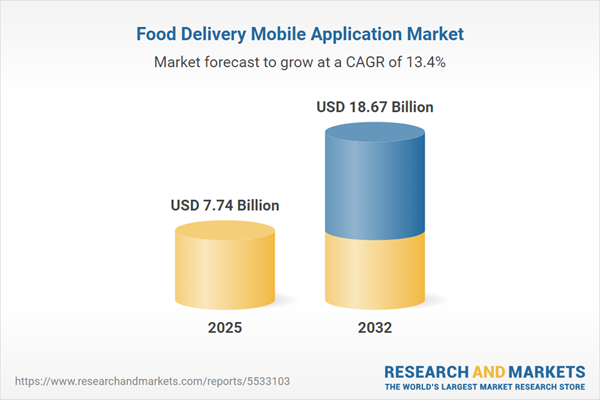Speak directly to the analyst to clarify any post sales queries you may have.
The food delivery mobile application market is undergoing significant transformation due to evolving technology, regulatory changes, and shifting user expectations. Senior decision-makers are tasked with navigating this landscape to drive sustainable growth and competitive advantage.
Market Snapshot: Food Delivery Mobile Application Market Size and Growth
The global food delivery mobile application market is experiencing robust and sustained growth, propelled by widespread smartphone adoption, greater integration of digital payment systems, and the rapid move toward online-first ordering habits. Market leaders continue to invest in enhanced application features and adaptable logistics, driving user engagement and expanded operational reach. Emphasis on scalable digital platforms is enabling companies to differentiate themselves, while organizations focused on leveraging data-driven strategies and responsive planning are positioned for continued expansion within this highly competitive sector.
Scope & Segmentation: Food Delivery Mobile Application Market Coverage
- Delivery Mode: In-house fleet management, third-party logistics, and customer pickup all offer organizations the flexibility to tailor their last-mile strategies, optimizing efficiency and adapting to variable regional demand profiles.
- Device Platform: Seamless functionality across Android and iOS broadens audience coverage and streamlines maintenance processes, crucial in a mobile-centric business environment.
- Payment Method: Digital wallets, credit and debit card processing, and cash-on-delivery bolster customer confidence and participation, addressing varied levels of digital adoption across different markets.
- Order Type: Scheduled and on-demand fulfillment options allow organizations to respond dynamically to user preferences and fluctuations in order activity, improving operational effectiveness.
- Regional Analysis: Customized solutions for the Americas, Europe, Middle East & Africa, and Asia-Pacific ensure compliance with diverse regulatory environments, helping accelerate adoption and market penetration.
- Company Analysis: Leading players such as DoorDash, Meituan Inc., Zomato Limited, Delivery Hero SE, Uber Technologies, Just Eat Takeaway.com, Deliveroo PLC, iFood Comércio Eletrônico S.A., Bundl Technologies Private Limited, and Grab Holdings Limited illustrate how sector focus and technological investment drive strong competitive positioning.
Key Takeaways: Strategic Insights for Senior Decision-Makers
- Artificial intelligence and geolocation capabilities are optimizing order handling, enabling precise real-time delivery tracking, and elevating customer satisfaction with faster and more reliable fulfillment.
- Subscription models and loyalty programs are emerging as effective approaches to retain customers and foster brand affinity, especially among tech-savvy user segments.
- Modernizing kitchen infrastructure and adopting contactless, digital-first delivery approaches empower organizations to meet evolving safety expectations and facilitate operational scale-up.
- Investments in localization—from regional language support to customized payment integrations—enhance market accessibility and regulatory alignment.
- Advancements in sustainable packaging and last-mile optimization are increasingly critical for meeting environmental norms and fulfilling broader corporate responsibility goals.
Tariff Impact: Navigating Near-Term Regulatory Challenges
The introduction of U.S. tariffs is presenting near-term cost implications for delivery logistics and packaging. To mitigate these pressures, organizations are recommended to relocate logistics hubs closer to strategic markets and expand their supplier base. Leveraging robust digital procurement processes supports better cost management and sourcing dependability. Predictive analytics and structured scenario modeling further equip companies to anticipate regulatory changes and ensure ongoing operational resilience.
Methodology & Data Sources
This report is developed from interviews with senior executives, expert input from technology leaders, and validated secondary research. Scenario-driven modeling techniques provide actionable guidance for enterprises adapting to the evolving food delivery mobile application landscape.
Why This Report Matters: Food Delivery Mobile Application Market
- Provides frameworks for benchmarking digital transformation and aligning goals with current industry standards, supporting agile planning and decision-making.
- Offers actionable resources for guiding regional expansion and managing regulatory and technological changes effectively.
- Equips leaders to sustain ongoing innovation and adapt to changing user requirements, protecting competitive positioning in volatile markets.
Conclusion
Aligning technology strategies and operations with current regulatory and market shifts ensures organizations remain resilient and well-positioned for long-term success in the food delivery mobile application sector.
Additional Product Information:
- Purchase of this report includes 1 year online access with quarterly updates.
- This report can be updated on request. Please contact our Customer Experience team using the Ask a Question widget on our website.
Table of Contents
3. Executive Summary
4. Market Overview
7. Cumulative Impact of Artificial Intelligence 2025
Companies Mentioned
The companies profiled in this Food Delivery Mobile Application market report include:- Meituan Inc.
- DoorDash, Inc.
- Delivery Hero SE
- Uber Technologies, Inc.
- Just Eat Takeaway.com N.V.
- Zomato Limited
- Deliveroo PLC
- iFood Comércio Eletrônico S.A.
- Bundl Technologies Private Limited
- Grab Holdings Limited
Table Information
| Report Attribute | Details |
|---|---|
| No. of Pages | 198 |
| Published | October 2025 |
| Forecast Period | 2025 - 2032 |
| Estimated Market Value ( USD | $ 7.74 Billion |
| Forecasted Market Value ( USD | $ 18.67 Billion |
| Compound Annual Growth Rate | 13.4% |
| Regions Covered | Global |
| No. of Companies Mentioned | 11 |









